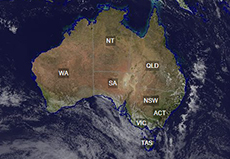Take Note – BOM Long-Range Forecast Overview

The Bureau of Meteorology (BOM) has issued the latest long-range forecast overview on 24 August, here. For September to November BOM is forecasting:
- Below median rainfall is likely to very likely (60% to greater than 80% chance) for most of Australia
- Above median maximum temperatures are very likely (greater than 80% chance) for almost all of Australia
- Warmer than median minimum temperatures are likely (60% to 80% chance) for most of Australia, with chances increasing to very likely (greater than 80% chance) for western and eastern areas
- Including likely El Niño development, potential positive Indian Ocean Dipole development, and record warm oceans globally
The following advice has been supplied to us from Bridie Carr, Senior Extension Horticulturist at the Department of Agriculture and Fisheries:
Impacts of extreme heat can include floral abscission, fruit drop, reduction in fruit size, reduced photosynthesis, and root death. Protecting avocado trees from heat events starts with optimum orchard setup and healthy trees. The best thing to do for managing heat stress from heat events is to anticipate the stress and get the water on before it arrives. Hydrating trees prior to heat stress to keep stomata open is crucial, as a water-stressed tree cannot effectively respond to heat stress, and a heat-stressed tree cannot meet water demand due to closed stomata. If the stomata close the plant begins to heat up and sunburn occurs. The aim is to prevent the closure of the stomata (transpiration) which begins to take place in periods of heat stress when temperatures are above ~35 degrees Celsius. Stomata also close during light stress (low light/intensity) and water stress. Hydrating trees prior to heat stress to keep stomata open is crucial, as a water-stressed tree cannot effectively respond to heat stress, and a heat-stressed tree cannot meet water demand due to closed stomata.
Preventing heat damage to avocado can be assisted through environmental management, applying protectants, and managing nutrition.
- Optimal irrigation management (reducing water stress) – monitoring soil moisture and temperature
- Windbreaks (increases humidity and evaporative cooling)
- Mulch (soil temperature cool, keeps roots cool, healthy more resilient tree)
- Overhead misting/irrigation (microclimate management, common practice in Tristate – turn on automatically when >32 degrees)
- Cover cropping/inter-row cropping to reduce soil radiation off bare soil (burning foliage and cooking roots)
- White paint/sunscreen on trunks for sunburn protection before pruning trees (easier to apply before rather than after pruning)
- Good nutrition – a healthy tree is more resilient and will withstand a heat event better than an unhealthy one
Growers also need to be considering what this may mean for future water resourcing and adjusting your business plans appropriately. The BPR has resources and further information to support you managing your orchard, under the growing section HERE.
This article appears as part of the Guacamole 1 September 2023 issue.
Date Published: 31/08/2023